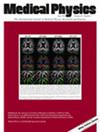Optimization of reconstruction in quantitative brain PET images: Benefits from PSF modeling and correction of edge artifacts
IF 3.2
2区 医学
Q1 RADIOLOGY, NUCLEAR MEDICINE & MEDICAL IMAGING
引用次数: 0
Abstract
BackgroundModern PET reconstruction algorithms incorporate point‐spread‐function (PSF) correction to mitigate partial volume effect. However, PSF correction can introduce edge artifacts that lead to quantification errors. Consequently, current international guidelines advise against using PSF correction in brain PET reconstruction.PurposeWe aimed to investigate PSF‐induced quantification errors in recent digital PET systems and identify conditions that mitigate them. This study utilized brain PET imaging with alginate‐based realistic phantoms, simulating lesion‐to‐background activity ratios of 10:1 and 2:1, with eleven reconstruction parameter sets.MethodsPhantoms were prepared using a commercial anthropomorphic head phantom and two homemade inserts. Each insert contained a homogeneous优化定量脑 PET 图像的重建:PSF 建模和边缘伪影校正的优势
背景现代 PET 重建算法采用点扩散函数(PSF)校正来减轻部分容积效应。然而,PSF校正会引入边缘伪影,导致量化误差。因此,目前的国际指南建议在脑 PET 重建中不要使用 PSF 校正。目的我们旨在研究近期数字 PET 系统中 PSF 引起的量化误差,并找出可减轻误差的条件。本研究利用基于藻酸盐的逼真模型进行脑 PET 成像,模拟病变与背景活动比为 10:1 和 2:1,并设置了 11 个重建参数。每个插入物都包含均匀的 18F-FDG 藻酸盐背景和不同直径(3、4、6、8、10、12 和 15 毫米)的热球。PET 成像在数字 PET-CT 系统 Biograph Vision 600(西门子)上进行,扫描时间为 10 分钟。成像在进行或不进行 PSF 校正、2、4、6、12、18 或 24 次迭代重建以及附加或不附加高斯后滤波的情况下进行。我们评估了每种球体大小和重建参数集的恢复系数 (RC)、对比度恢复系数 (CRC)、可变性和 CRC 与可变性比率。相比之下,2:1 球体的 PSF 图像显示出单调递增的关系。两种模型的非 PSF 图像都显示出预期的 CRC 与球体直径的单调递增关系,但与 PSF 图像相比,CRC 值较低。通过应用 3 毫米 FWHM 高斯后滤波,10:1 球体观察到的非单调关系得到了缓解。对于两个模型,迭代 6 次、PSF 校正和额外的 3 mm FWHM 高斯后过滤重建显示出最高的 CRC 变异比。我们的研究结果表明,高斯后滤波可抑制 PSF 伪影,与非 PSF 重建相比,该参数集纠正了 CRC 与球直径之间的非单调关系,提高了 CRC 与变异率。因此,为了在不影响量化准确性的情况下提高病变的可探测性,应在脑 PET 中使用 PSF 校正和高斯后滤波。
本文章由计算机程序翻译,如有差异,请以英文原文为准。
求助全文
约1分钟内获得全文
求助全文
来源期刊

Medical physics
医学-核医学
CiteScore
6.80
自引率
15.80%
发文量
660
审稿时长
1.7 months
期刊介绍:
Medical Physics publishes original, high impact physics, imaging science, and engineering research that advances patient diagnosis and therapy through contributions in 1) Basic science developments with high potential for clinical translation 2) Clinical applications of cutting edge engineering and physics innovations 3) Broadly applicable and innovative clinical physics developments
Medical Physics is a journal of global scope and reach. By publishing in Medical Physics your research will reach an international, multidisciplinary audience including practicing medical physicists as well as physics- and engineering based translational scientists. We work closely with authors of promising articles to improve their quality.
 求助内容:
求助内容: 应助结果提醒方式:
应助结果提醒方式:


